程序和生活一样都会出现异常,先来看个异常:
上面出现的是算数错误的异常。
在java中,除去一些编译上的错误(语法)之外,就有异常和错误!
异常的定义是可自己进行处理后,程序依然可以正常运行下去!错误是Java虚拟机抛出的,终止程序的运行,这就是程序和异常的区别。
一:什么是异常处理?
异常处理机制就像我们对平时可能遇到的意外情况,预先想好了一些处理的办法。也就是说,在程序执行代码的时候,万一发生了异常,程序会按照预定的处理办法对异常进行处理,异常处理完毕后,程序继续运行。
java的异常处理是通过5个关键字来实现的:try、catch、finally、throw、throws。
二:java异常类的层次结构
三.常见的异常类型
- Exception 异常层次结构的根类
- ArithmeticException 算数错误情形
- ArrayIndexOutOfBoundsException 数组下标越界
- NullPointerException 尝试访问null对象成员
- ClassNotFoundException 不能加载所需的类
- InputMismatchException 欲得到的数据类型与实际输入的类型不匹配
- IllegalArgumentException 方法接受到非法参数
- ClassCastException 对象强制类型转换出错
NumberFormatException 数字格式转换异常
四.具体实例
try—catch
package Test;
import java.util.Scanner;
public class Test_Test {
public static void main(String[] args) {
Scanner input =new Scanner(System.in);
System.out.println("请输入被除数:");
try {
int num1=input.nextInt();
System.out.println("请输入除数:");
int num2=input.nextInt();
System.out.println(String.format("%d / %d = %d",
num1, num2, num1 / num2));
}catch (Exception e) {
System.err.println("出现错误:被除数和除数必须是整数,"+
"除数不能为零。");
System.out.println(e.getMessage());
}
}运行结果如下:
System.err.println();这种输出方式可以输出错误的消息,在控制台呈现红色。
System.out用于正常的输出,也就是程序真正想输出的内容。而System.err用于出错信息的输出,也就是你本来不期待看到的东西。
System.out.println(e.getMessage());
这行的作用是——返回该错误的详细信息的字符串。
try-catch-finally
package Test;
import java.util.Scanner;
public class Test_Test {
public static void main(String[] args) {
Scanner input =new Scanner(System.in);
System.out.println("请输入被除数:");
try {
int num1=input.nextInt();
System.out.println("请输入除数:");
int num2=input.nextInt();
System.out.println(String.format("%d / %d = %d",
num1, num2, num1 / num2));
}catch (Exception e) {
System.err.println("出现错误:被除数和除数必须是整数,"+
"除数不能为零。");
System.out.println(e.getMessage());
}
finally{
System.out.println("Thanks");
}
}
}运行结果如下:
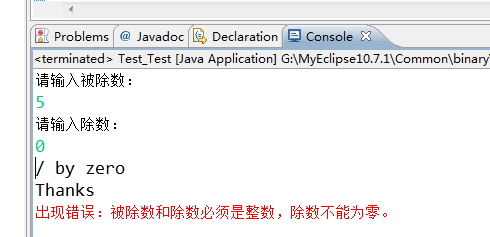
try-catch-finally 程序块的流程大致分为两种情况:
- 如果try块中所有语句正常执行完毕,那么finally块就会被执行。
- 如果try语句在执行过程中碰到异常,无论这种异常能否被catch块捕获到,都将执行finally块中的代码。
try-catch-finally结构中try块是必须有的,catch和finally块为可选,但两者至少必须出现其中之一。
try—catch-catch-finally(多重catch块)
package Test;
import java.util.InputMismatchException;
import java.util.Scanner;
public class Test_Test {
public static void main(String[] args) {
Scanner input =new Scanner(System.in);
System.out.println("请输入被除数:");
try {
int num1=input.nextInt();
System.out.println("请输入除数:");
int num2=input.nextInt();
System.out.println(String.format("%d / %d = %d",
num1, num2, num1 / num2));
}catch (InputMismatchException e) {
System.err.println("被除数和除数必须是整数。");
}
catch (ArithmeticException e) {
System.err.println("除数不能为零。");
}
catch (Exception e) {
System.err.println("其他未知异常。");
System.out.println(e.getMessage());
}
finally{
System.out.println("Thanks");
}
}
}运行结果如下:
所以,在写异常处理的时候,一定要把异常范围小的放在前面,范围大的放在后面,Exception这个异常的根类一定要刚在最后一个catch里面,如果放在前面或者中间,任何异常都会和Exception匹配的,就会报已捕获到…异常的错误。
下面是try-catch-finally中包含return的情况:
情况一:try{} catch(){}finally{} return;
正常按程序顺序执行即可。
package Test;
public class Test_Test {
public static void main(String[] args) {
Test1();
}
public static int Test1(){
int x = 1;
try
{
x++;
System.out.println("我有用!");
}
catch (Exception e) {
System.out.println("我没用!");
}
finally
{
++x;
System.out.println("我也有用!");
}
return 2;
}
}运行结果如下:
情况2:try{ return; }catch(){} finally{} return;
程序执行try块中return之前(包括return语句中的表达式运算)代码;
再执行finally块,最后执行try中return;
finally块之后的语句return,因为程序在try中已经return所以不再执行。
package Test;
public class Test_Test {
public static void main(String[] args) {
Test1();
}
public static int Test1(){
int x = 1;
try
{
x++;
System.out.println("我有用!");
return 6;
}
catch (Exception e) {
System.out.println("我没用!");
}
finally
{
++x;
System.out.println("我也有用!");
}
return 2;
}
}运行结果如下:
情况3:try{} catch(){return;} finally{} return;
程序先执行try,如果遇到异常执行catch块,
有异常:则执行catch中return之前(包括return语句中的表达式运算)代码,再执行finally语句中全部代码,
最后执行catch块中return. finally之后也就是4处的代码不再执行。
无异常:执行完try再finally再return.
1.有异常的情况:
package Test;
public class Test_Test {
public static void main(String[] args) {
Test1();
}
public static int Test1(){
int x = 5;
try
{
int num=x / 0;
System.out.println(num);
}
catch (ArithmeticException e) {
System.err.println("除数不能为0!");
return 6;
}
finally
{
++x;
System.out.println("finally");
}
return 2;
}
}运行结果如下:

2.无异常的情况:
package Test;
public class Test_Test {
public static void main(String[] args) {
Test1();
}
public static int Test1(){
int x = 5;
try
{
System.out.println("try");
}
catch (ArithmeticException e) {
System.err.println("除数不能为0!");
return 6;
}
finally
{
++x;
System.out.println("finally");
}
return 2;
}
}运行结果如下:
情况4:try{ return; }catch(){} finally{return;}
程序执行try块中return之前(包括return语句中的表达式运算)代码;
再执行finally块,因为finally块中有return所以提前退出。
package Test;
public class Test_Test {
public static void main(String[] args) {
Test1();
}
public static int Test1(){
int x = 5;
try
{
int num = x / 0;
System.out.println("try");
return 3;
}
catch (ArithmeticException e) {
System.err.println("除数不能为0!");
}
finally
{
++x;
System.out.println("finally");
return 2;
}
}
}运行结果如下:
情况5:try{} catch(){return;}finally{return;}
程序执行catch块中return之前(包括return语句中的表达式运算)代码;
再执行finally块,因为finally块中有return所以提前退出。
package Test;
public class Test_Test {
public static void main(String[] args) {
Test1();
}
public static int Test1(){
int x = 5;
try
{
int num = x / 0;
System.out.println("try");
}
catch (ArithmeticException e) {
System.err.println("除数不能为0!");
return 4;
}
finally
{
++x;
System.out.println("finally");
return 2;
}
}
}运行结果如下:
情况6:try{ return;}catch(){return;} finally{return;}
程序执行try块中return之前(包括return语句中的表达式运算)代码;
有异常:执行catch块中return之前(包括return语句中的表达式运算)代码;
则再执行finally块,因为finally块中有return所以提前退出。
无异常:则再执行finally块,因为finally块中有return所以提前退出。
1.有异常
package Test;
public class Test_Test {
public static void main(String[] args) {
Test1();
}
public static int Test1(){
int x = 5;
try
{
int num = x / 0;
System.out.println("try");
return 4;
}
catch (ArithmeticException e) {
System.err.println("除数不能为0!");
return 4;
}
finally
{
++x;
System.out.println("finally");
return 2;
}
}
}运行结果如下:
2.无异常
package Test;
public class Test_Test {
public static void main(String[] args) {
Test1();
}
public static int Test1(){
int x = 5;
try
{
// int num = x / 0;
// System.out.println("try");
return 4;
}
catch (ArithmeticException e) {
System.err.println("除数不能为0!");
return 4;
}
finally
{
++x;
System.out.println("finally");
return 2;
}
}
}运行结果如下:
最终结论:
任何执行try 或者catch中的return语句之前,都会先执行finally语句,如果finally存在的话。
如果finally中有return语句,那么程序就return了,所以finally中的return是一定会被return的,
编译器把finally中的return实现为一个warning。
throw——抛出异常
抛出异常有三种形式,一是throw,一个throws,还有一种系统自动抛异常。
系统抛出异常:
package Test;
public class Test2 {
public static void main(String[] args) {
int a = 5, b =0;
System.out.println(5/b);
}
}运行结果如下:
throw抛出异常:
throw是语句抛出一个异常。
语法:throw (异常对象);
package Test;
public class Test2 {
public static void main(String[] args) {
String s = "abc";
if(s.equals("abc")) {
throw new NumberFormatException();
} else {
System.out.println(s);
}
}
}运行结果如下:
throws——声明异常
throws是方法可能抛出异常的声明。(用在声明方法时,表示该方法可能要抛出异常)
语法:(修饰符)(方法名)([参数列表])[throws(异常类)]{……}
package Test;
public class Test2 {
public static void main(String[] args) {
try {
Test3();
} catch (NumberFormatException e) {
System.err.println("非数据类型不能转换。");
}
}
public static void Test3() throws NumberFormatException{
String s = "abc";
System.out.println(Double.parseDouble(s));
}
}运行结果如下:

如果在一个方法体中抛出了异常,那么我们就可以通过throws——声明异常来通知调用者,非常方便。
throws表示出现异常的一种可能性,并不一定会发生这些异常;throw则是抛出了异常,执行throw则一定抛出了某种异常对象。
最后说一句,try-catch-finally虽好用,但是如果是滥用,这样只是会让程序的可读性变的很糟糕,当程序报错,就无法快速准确的定位了,物尽其用 人尽其才嘛!









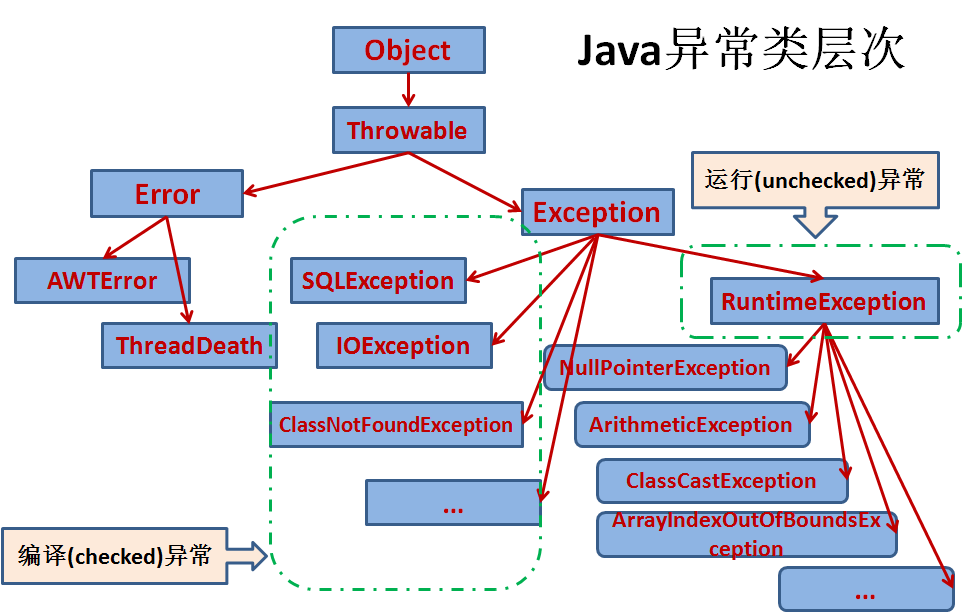
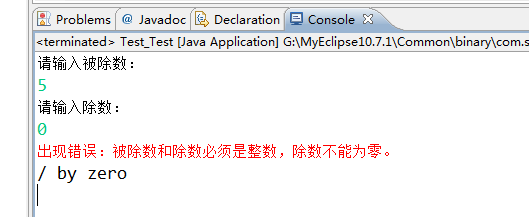
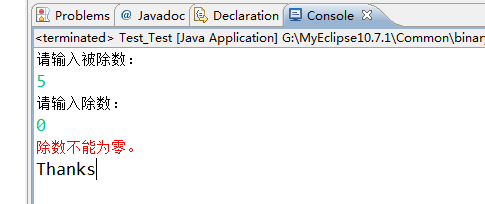


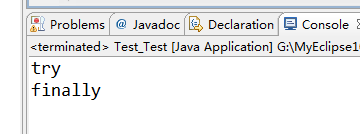
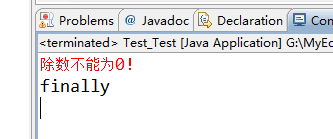
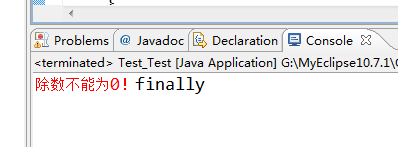
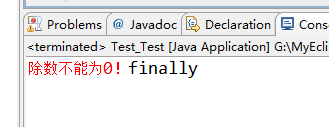
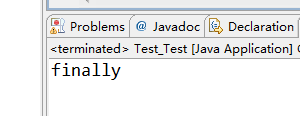
















 1246
1246

 被折叠的 条评论
为什么被折叠?
被折叠的 条评论
为什么被折叠?








